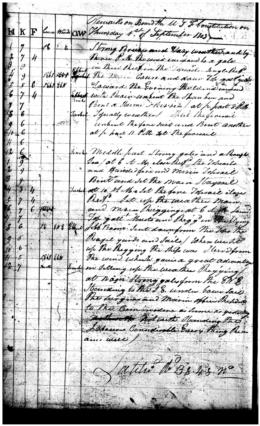
NavList:
A Community Devoted to the Preservation and Practice of Celestial Navigation and Other Methods of Traditional Wayfinding
Re: Attempting to decipher a "time sight"
From: Don Seltzer
Date: 2016 May 31, 14:40 -0400
On Tue, May 31, 2016 at 2:13 PM, Ed Popko <NoReply_EdPopko@fer3.com> wrote:
>
> ... was 'high noon' ship's time 12:00 or 00:00 start of next day. I can usually recreate their Time Sight calculations but I typically have to cycle through a few guesses as to how ship's time was kept.
>
> What were the practices during the 19th C and what are the tip offs when you look at old nav scribbles?
One indicator is how the daily pages of the log or journal were laid out. The 18th century practice was to mark out 24 lines beginning with 1 pm. The ship's day as recorded were the 12 pm hours followed by the 12 am hours, ending at noon with the day's reckoning. The date at the top of the page would lead the conventional civilian time by half a day. That is, as I write this at about 2:30 pm on Tuesday May 31st, my 18th century log book would record this hour on Wednesday June 1st.
The Royal Navy followed this practice until 1805, I believe. After that, the Admiralty issued new official standards for log books in which each page corresponded to civilian time keeping, with the top line 12 midnight, all of the am hours, 12 noon in the middle of the page, and all of the pm hours following.
Merchant ships continued to stick to the old ways for many decades into the 19th century.
Don Seltzer
From: Don Seltzer
Date: 2016 May 31, 14:40 -0400
On Tue, May 31, 2016 at 2:13 PM, Ed Popko <NoReply_EdPopko@fer3.com> wrote:
>
> ... was 'high noon' ship's time 12:00 or 00:00 start of next day. I can usually recreate their Time Sight calculations but I typically have to cycle through a few guesses as to how ship's time was kept.
>
> What were the practices during the 19th C and what are the tip offs when you look at old nav scribbles?
One indicator is how the daily pages of the log or journal were laid out. The 18th century practice was to mark out 24 lines beginning with 1 pm. The ship's day as recorded were the 12 pm hours followed by the 12 am hours, ending at noon with the day's reckoning. The date at the top of the page would lead the conventional civilian time by half a day. That is, as I write this at about 2:30 pm on Tuesday May 31st, my 18th century log book would record this hour on Wednesday June 1st.
The Royal Navy followed this practice until 1805, I believe. After that, the Admiralty issued new official standards for log books in which each page corresponded to civilian time keeping, with the top line 12 midnight, all of the am hours, 12 noon in the middle of the page, and all of the pm hours following.
Merchant ships continued to stick to the old ways for many decades into the 19th century.
Don Seltzer







